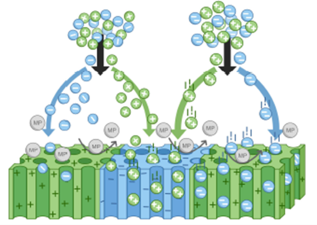Design of novel Membrane Processes for the effective removal of Micropollutants through Charge-Mosaic Nanofiltration Membranes
- Persons involved: Purvil Gangar (PhD), Wiebe de Vos (Promotor), Sander Haase (Supervisor), Gerrald Bargeman (Supervisor)
- Duration: 2024-2028
- Funding: European Research Council (ERC) Consolidator Grant Mosaic
Introduction
Rising concentrations of organic micro-pollutants (OMPs) in water sources pose a significant threat to human health and ecosystems worldwide. These OMPs, originating from various sources such as industrial, agricultural, pharmaceutical, and chemical residues, present a significant threat to both human health and the environment. Addressing this issue is imperative to safeguard human and aquatic life. While Reverse Osmosis and Nanofiltration membranes hold promise as solutions, they come with notable drawbacks. These include low water permeability, the requirement for high pressures, significant salt retention, and the need for remineralization of the permeate to ensure its suitability for drinking water.
New and innovative technologies are needed to overcome these drawbacks. One possible route involves the creation of charge-mosaic membranes, which integrate both positive and negative charged domains. This concept is promising, because it allows essential minerals to pass the membrane, while the membrane effectively blocks OMP molecules at the same time.
Key words
Charge-Mosaic Membranes, Nanofiltration, Organic MicroPollutants (OMPs)
Technological/Scientific challenges
While a notable obstacle yet is the production of charge-mosaic membranes with positive and negative charge domains small enough to achieve the desired efficacy 1-3, this project will aim at the design, optimization and valorisation of charge-mosaic nanofiltration membranes. Leveraging their distinctive separation properties, the goal is to deploy a membrane capable of efficiently removing OMPs from both drinking water and municipal wastewater streams. Scaling up of the process for practical implementation will be a challenge at a later stage in this project.

Schematic representation of a Charge-Mosaic Membrane
Objectives
The unique separation properties of charge-mosaic membranes will allow the development of novel membrane processes. This project will focus on developing and optimizing charge-mosaic membrane processes to efficiently remove organic micropollutants (OMPs) from drinking water and municipal wastewater, delving into the practical aspects of scaling up the developed membrane processes for widespread implementation. This will include assessing the feasibility of integrating charge-mosaic membranes into existing water treatment facilities on a larger scale, such as drinking and municipal water treatment plants.
References
- Söllner, K., Uber Mosaikmembranen, Biochem. Z. 244 (1932) 370
- T. Fujimoto, K. Ohkoshi, Artificial membranes from multiblock copolymers. I. Fabrication of a Charge-Mosaic membrane and preliminary tests of dialysis and piezodialysis, J. Membr. Sci. 20 (1984) 313.
- Summe, M. J.; Sahoo, S. J.; Whitmer, J. K.; Phillip, W. A., Salt permeation mechanisms in charge-patterned mosaic membranes. Molecular Systems Design & Engineering 2018, 3 (6), 959-969

